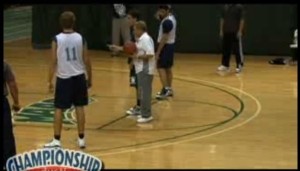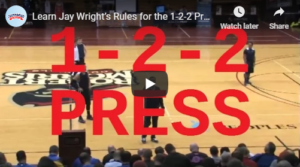This is the second part of an article that was written by Rick Majerus several years ago. The focus is what he looks for when recruiting, but some of these concepts can be taught and others can be improved upon through work.
Here is a link to the first part of the article: Evaluating Basketball Players Part I
Passers that appeal to me are those who pass the ball away from the defense. Outstanding passers have that snap on the ball that you can’t coach. They deliver it quickly and effortlessly by using their wrists.
I’m continually looking for those players that dribble to improve their passing angle (a lost art and a hard to teach concept). It is easy to find players that can pass in the open court, difficult to find players that can penetrate and pitch effectively in the paint, but next to impossible to find people who can feed a stationary or flash post by ball faking and dribbling to improve the angle of the pass. A good passer takes the ball up to the defense and that’s a trait often overlooked by most.
On a break, I try to find a man who will come to a controlled stop, let a wing fill a lane and be patient enough to give the wing the ball at the most opportune time so the play is made by virtue of the precision pass as opposed to the wing having to execute a difficult move off the dribble because the ball was thrown to soon. Good passers have poise and patience above all else. They anticipate, see the court and read the defense. (not only the defender covering the receiver but the “off the ball” help as well.)
Finally, a really smart passer doesn’t put the ball in the corner unless that man has a shot and he never passes to a man who has begun to cut away from the hoop. The great passer recognizes the difference in those players who are open for a shot or to better position the ball within the confines of the offense.
Good ball handlers are easy to spot. They are at least adequate with both hands. A great dribbler is one who can go full speed up and down the length of the court with either hand and come to a stop under control. A super dribbler is one who can change direction with the ball, head and shoulder fake and change pace accelerating rapidly by the defender. When I see this happen, I know the kid’s a keeper.
A real test of a ball handler comes when he encounters full court pressure. An average guard turns his back against pressure or goes with the playground “spin move.” A heady guard uses a pull back crossover dribble so as to maintain vision up court thus eliminating the likelihood of a double team or trap. And last of all, a great ball handler can back up with the ball. He’ll do it to reset the offense, or perhaps to avoid a trap, and this is an indication to me that the young man is a bright player and can handle the ball. A player who can do all of the aforementioned in addition to shoot the ball is really a find.
It is difficult to appreciably improve someone’s shooting in college. You may be able to make a small change but a complete overhaul is next to impossible. Players revert back to the habits of a lifetime making it extremely difficult for collegiate players to improve on technique. A good shooter has range and there’s a correlation between effective range and leg spring. I’m not as concerned if his elbow is in or out as I am with release and follow-through. A player who can shoot usually has good rotation on the ball, little wasted motion, and an exaggerated follow through. He exudes confidence and can shoot without having to take a rhythm bounce. Those that can shoot it know their range, lack of indecision, and spot up according to the penetration of the ball.
The Coaching Toolbox has hundreds of resources for basketball coaching including basketball practice, basketball plays, basketball drills, basketball quotes, basketball workouts, basketball poems, and more!









